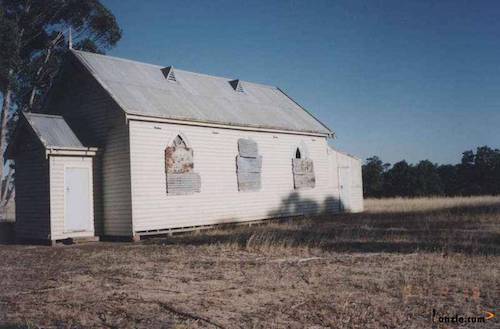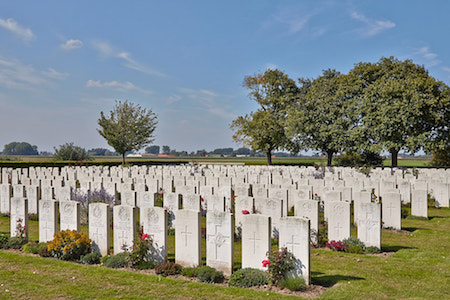
FOOTNOTES CHAPTER FIVE
[1] "Horsham Times" Jan 1909.
[2] The Bible was that referred to in Chapter One in the possession of Mrs Olive Rossack, (formerly Perkins), of Geelong
[3] Recollection of Olive Rossack as recalled by Theresa McFarlane.
[4] Charles was apparently an original selector in the Nurrabiel district as were the Featherbys. A map indicating the actual selections of Charles Henry Bond and William Featherby (either Betsy's father or her cousin - see previous Chapter) was shown to me by a Mr Wilson of Nurrabiel, who now has possession. His property also includes part of Charles' original holding which was still referred to as "Bond's Paddock".
Another interesting sidelight from this time is to be found in the "Horsham Times" of Nov 15th 1887, where an account of the Prince of Wales Birthday Picnic is included in the Nurrabiel news. The name of the handicapper for the races was given as C.H.Bond, and some interesting names also appear among the results. eg. Boy's third race:- 1. H.Featherby, 2. H.Wilson, 3. H.Bond; Boy's fourth race:- 1. E.Hannon, 2. G.Roberts, 3. W.Bond. (William James Bond would have then been 9 yrs-old.)
A book recording the minutes of the meetings of the Trustees of the Nurrabiel Methodist Church was also shown to me by Mr Wilson. According to the record of the minutes, Charles Henry Bond and Henry Featherby were elected as Trustees on April 22nd 1884. Following his election, Charles in particular seems to have been extremely active in planning for the construction of the church in that year (A church which was still in use in the 1980's although now closed) - at least to judge from the number of motions which he either proposed or seconded.

Nurrabiel Methodist church (closed and since demolished)
[5] From the records of the Nurrabiel cemetery obtained through the courtesy of Mr W.Gill of Nurrabiel.
[6] According to the minutes of the meetings of the Trustees of the Nurrabiel Methodist Church a motion was passed on Nov 28th 1889 voting off Mr C.H.Bond as a Trustee as "he has left the district".
Of the other children of Charles and Betsy apart from William (whose subsequent life is the subject of the main text), Charles Henry Jr later moved to Geelong where his son Stan operated a Radio/Television/Electrical store in Ryrie St. Charles died on July 1st 1942 and is buried in the Eastern cemetery, Geelong. Ellen married George Perkins and became the mother of Olive already referred to in this account. She died on June 28th 1970. Frances (Mrs Millhouse) died at Merebin in 1961, whilst Ann (Mrs Hood) although still living in Mildura at the time that this booklet was first written (1975) was unable to provide any information relating to the family history due to her advanced age and failing memory. She subsequently died on Sept 2nd 1977.
[7] Details supplied by Thelma Bond. In the 1891-92 Victorian Postal Directory, James Bond of Dimboola is listed as a Butcher.
[8] Date is estimated from the obituary notice for Charles which was published in the "Horsham Times" of Jan 1909.
[9] Death certificate of Elizabeth Bond.
[10] See Chapter Two, footnote 4.
[11] Death certificate of James Bond. Dates of birth are estimated from the ages shown thereon.
[12] The details of the Army career of Private Matthew Henry Bond were obtained from the Central Army Records Office in St Kilda Rd Melbourne. The date of his enlistment was May 15th 1916 (at Ballarat) at which time he was aged 23 yrs and 2 months. His place of birth was given as Pimpinio and his address was c/o the Pimpinio Post Office. He was single and gave his occupation as "Agent". A physical description was also recorded and he is described as being 5' 5" in height, weighing 165 lbs and with chest measurement of 37/39". He had a fair complexion, blue eyes, brown hair and scars at the base of the left forefinger. His religious denomination was Methodist.
After some initial training in Victoria he embarked on the "S.S.Commonwealth" on Sept 19th 1916 and arrived in Plymouth on Nov 14th 1916 - sixty years and one day after his father had left the same port bound for a new life in the colonies! After serving with the Australian Machine Gun Training Depot he embarked for France from Southampton in March 1917. He then served with the 22nd Machine Gun Company in France and Belgium. Probably he joined his unit in time to accompany it as it occupied its position in the front line on April 13th, at Noreuil near Bullecourt. As part of the 7th Brigade, the 22nd Machine Gun Company took part in the fierce fighting around Bullecourt, but lost only 4 men in an action where Australian casualties totalled 10,000. The Australians were partially successful in gaining and holding on to their objectives in this battle, but elsewhere the British offensive failed, and the Australian 2nd Division of which the 7th Brigade was part, was relieved on May 9th as the new front stabilized.
No doubt after this initial taste of battle Pte Matthew Bond would have welcomed the four month rest that the Australian forces were given from May until September of 1917. On Sept 12th the 2nd division began to move to Reningholst near Ypres from where it took part in the successful British attack on Sept 20th known as the Battle of Menin Road. (The 22nd M.G.Coy suffered the loss of 10 officers and 7 other ranks in this battle). Following this action the 2nd Division was relieved on the night of Sept 22-23. The following day Matthew Bond was treated at the 7th Field Ambulance for blistered feet before being transferred to the 2nd Casualty Clearing station (Oct 8th) and then to the 16th General Hospital at Le Treport (Oct 10th).
He eventually rejoined his unit on Nov 15th. and therefore missed the battles at Broodsiende and Passchendale in which his Company took part. By the time he re-joined his unit it had been relieved and was based in a quiet sector of the front near Messines. From Dec 16th to Jan 29th the 2nd Div. held a portion of the front line at Ploegsteert (south of Messines). No major battles were fought during this time, partly due no doubt to the prevailing wet, muddy and wintry conditions. Activity along the front was confined to small raiding parties from both sides which were intended to reconnoitre the enemies defences or identify the units to which opposing troops belonged.
It seems that Matthew Bond was wounded whilst either part of a raiding party or, as what seems more likely, an attack by a German raiding party. Whatever the case he was wounded in action in Belgium on Jan 12th 1918 and died of those wounds at the 2nd Australian Casualty Clearing Station on the same day. He was buried in the Commonwealth War Cemetery at Trois Arbres just outside the village of Steenwerck in France and very close to the Belgian border.

Trois-Arbres military cemetery, Steenwerck, France. Burial site of Matthew Bond
His grave which I visited in Jan 1989 and again in 2024, is No. 6 in Plot 2, Row D. As are all the war cemeteries which are to be found dotted throughout Picardy and western Belgium, it is beautifully maintained, and I found it a very moving experience to wander among the headstones noting the names, ages, places of origin and family inscriptions which mark the final resting place of so many young Australians.
[13] Details re Susan Emmett were supplied by the Trustees of the Pimpinio cemetery. Other details were supplied by Thelma Bond. The house referred to was still standing in Pimpinio when I visited sometime in the 1980s, although uninhabited and badly dilapidated.
According to Cis Smith, her own mother was in the habit of referring to Susan rather contemptuously as "old mother Emmett". She also alleged that her brother James Jr on one occasion had to force the door in order to see his seriously ill father as he had been refused entry by Susan who feared that James would pressure his father to change his will! Again according to her daughter, Annie never accepted Phillip, and on one occasion was said to have torn up a photograph she had received from him that had been signed "your brother" with the remark "he is no brother of mine". This seems to have had something to do with Annie's strong disapproval of Phillip's relationship with a Mrs Roy, a friend of Susan who had nursed her through her last illness, and who stayed on in the house with Phillip after Susan's death. Apparently Matthew seemed to be more accepted by Annie.
[14] Death certificate of James Bond.
[15] Probate of the will was granted to Robert Stanley of Pimpinio (farmer); Thomas Freeman of Horsham (farmer) and James Bond of Dimboola (farmer). The solicitor was John Weldon Power (& Bennett) and the will was dated Aug 28th 1905. The property was listed in two parts:- 1. Crown allotments 13 and 8 in the town of Pimpinio; and 2. Crown allotments 2 to 6 both inclusive of section 8 also in the town of Pimpinio. The former allotments represented an area of 54 acres, 1 rood, 23 perches, whilst the latter allotments contained 1 and 1/4 acres.
In the Horsham branch of the National Bank was deposited 158 pounds 11 shillings and 11 pence; in the Savings Bank at Horsham was 25 pounds 2 shillings and 3 pence, whilst in this same bank was 2000 pounds on fixed deposit. Debts due to the estate were listed as 20-2-6 to George Hallam of Pimpinio, 22-0-0 to John Scott Lawson of Dooen and 30-0-0 to James Young of Jung Jung.
[16] Information regarding the marriage was obtained from Betty Lamb through my cousin Norma Clingin (nee Ford). Betty was a daughter of Jane Anderson (a sister of William Bond) Betty stated that her mother told her that she had acted as a witness to the marriage. Although the wedding took place in a Presbyterian church, all the children were baptised as Catholics. (Charlie, William and Theresa were all baptised at Birregurra). William himself later took up the Catholic religion of his wife. My cousin Shirley Foley (nee Parsons) recalled that her grandmother Bridget once remarked that William's family had opposed his marriage to her because she was a Catholic.

GO TO CHAPTER SIX
RETURN TO CONTENTS PAGE